With thousands of miles of coastline, there’s no shortage of lighthouses in Washington State. These coastal beacons, whether perched on rocky cliffs or along sandy shoals, hark back to a time when keepers battled the elements to tend the lights that guided vessels to shore.
Today, dedicated volunteers maintain these buildings and historical sites, and many of Washington’s lighthouses are open to visitors. Climb to a light tower, immerse yourself in maritime history, or even stay overnight in a historic keepers’ cottage. Many of Washington’s lighthouses were constructed in the late 1800s and early 1900s, making them important maritime heritage buildings. History and architecture buffs can even visit some that are listed on the National Register of Historic Places, such as Point Wilson and Admiralty Head.
At a Glance: Washington Lighthouses
- Number of lighthouses: More than 21 lighthouses are dotted along the Pacific Coast, Puget Sound, islands, and rivers.
- Tallest lighthouse in Washington: Grays Harbor Lighthouse (107 feet, Westport)
- Oldest lighthouse in Washington: Cape Disappointment Lighthouse (1856, Long Beach Peninsula)
- Whale-watching hot spot: Lime Kiln Lighthouse, San Juan Island
- Accessibility: Tower climbs typically involve steep stairs, and some have height and age restrictions that can making climbing unsuitable for small children.
- Passes and permits: Many lighthouses sit within state parks, which require a Discover Pass to park your vehicle. Passes can be bought online or at participating retailers.
Washington Lighthouses: Peninsulas and Pacific Coast
Cape Disappointment Lighthouse, near Ilwaco
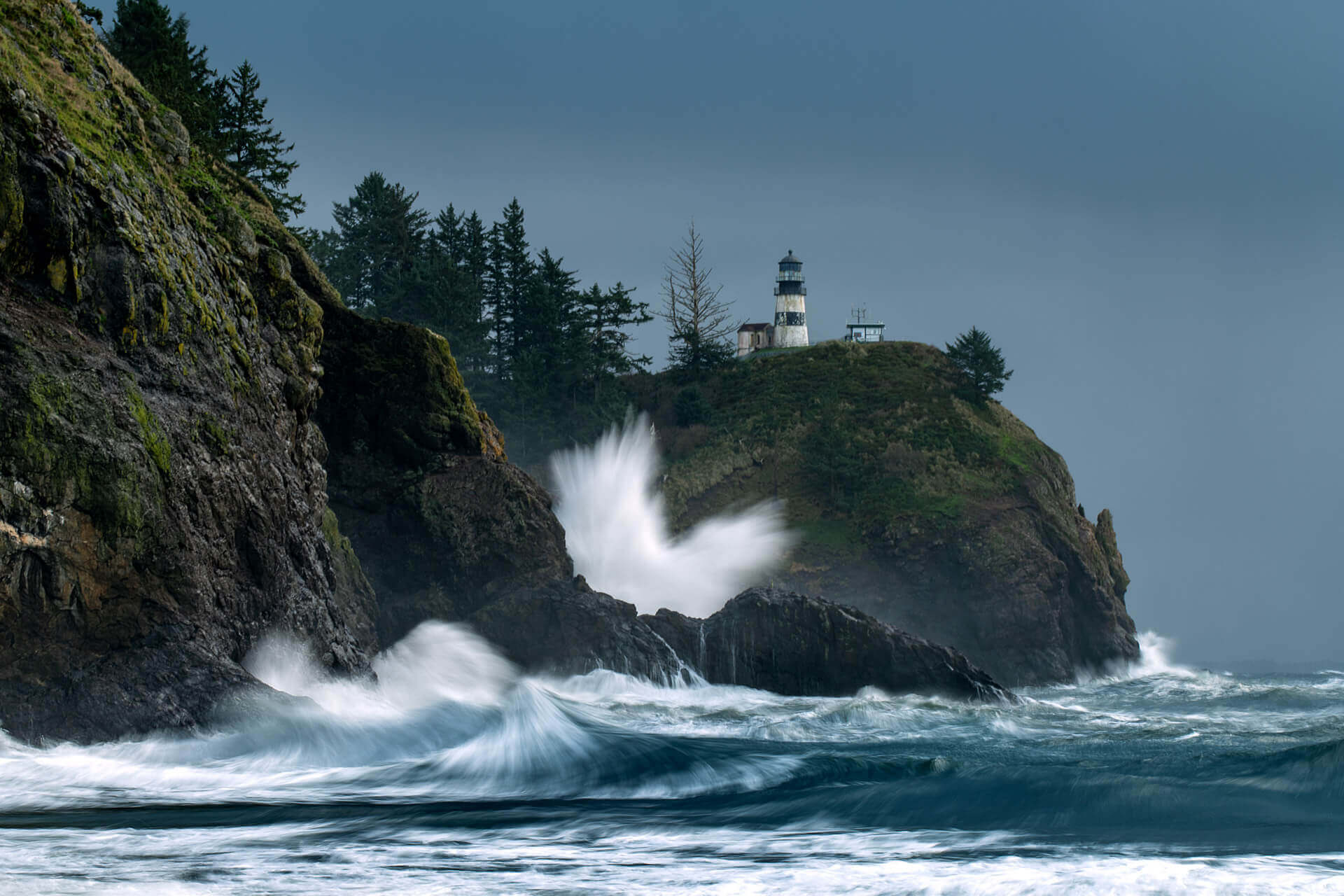
Year built: 1856
Located on the Long Beach Peninsula, the 53-foot-tall masonry lighthouse is the original of two lighthouses at Cape Disappointment. One of the oldest working lighthouses on the West Coast, this historic building overlooks the confluence between the Columbia River and Pacific Ocean. In 1973, the light switched to an automated system. Fun fact: Visitors can view the lighthouse’s original Fresnel lens at the nearby Lewis and Clark Interpretive Center.
While the inside isn’t accessible, visitors can hike to the lighthouse from the parking lot of the Interpretive Center (Discovery Pass required). The short trail winds along the bluffs above Dead Man’s Cove before reaching the historic site with sweeping ocean views.
Visitor hours and tours: Not currently available.
Also See: Best Beaches for Storm Watching
North Head Lighthouse, near Ilwaco
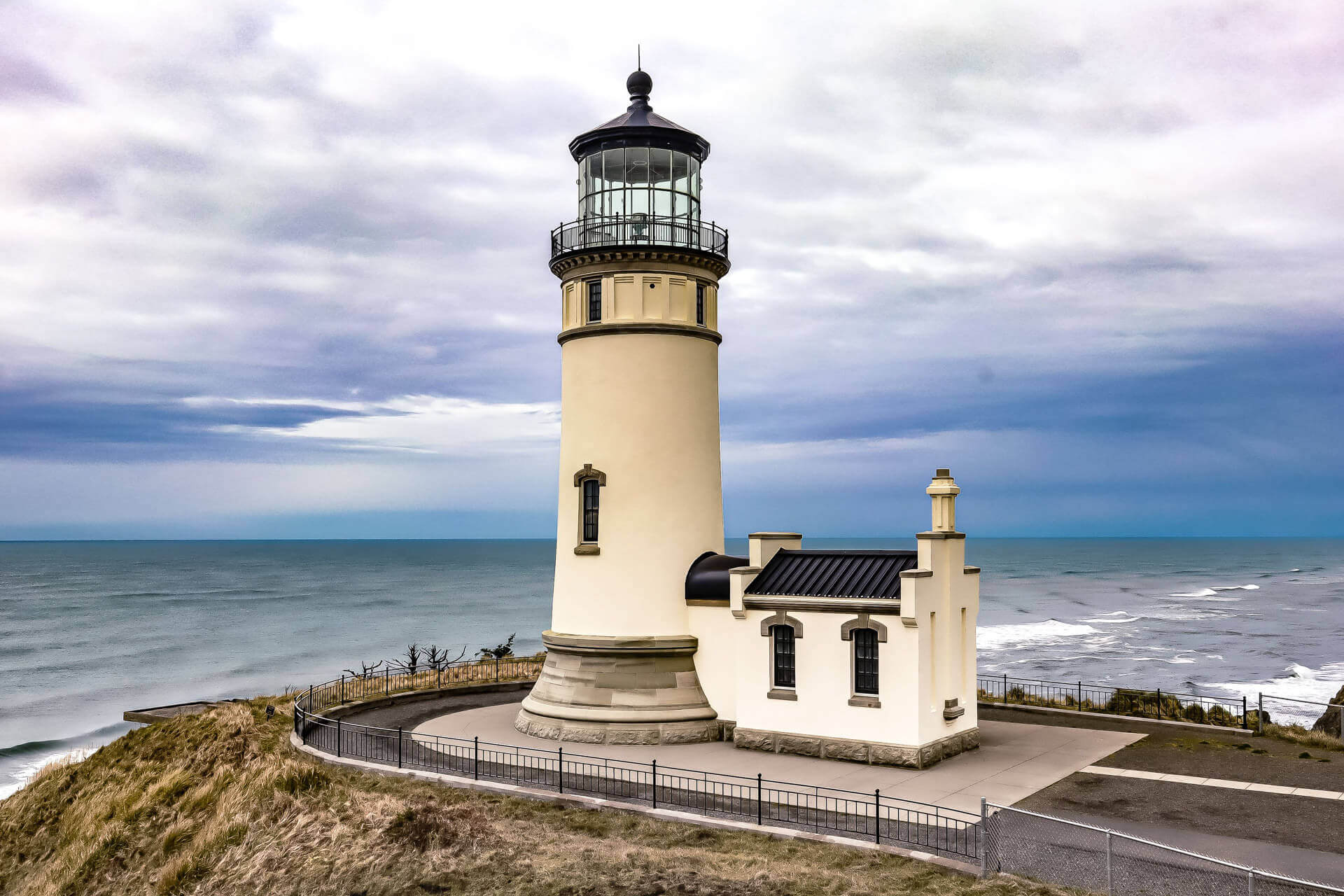
Year built: 1898
Despite the best efforts of the original Cape Disappointment Lighthouse (1856), shipwrecks continued to plague the area known as the “Graveyard of the Pacific.” In an effort to prevent this, an additional lighthouse was later built on the northwestern spur known as North Head. Today, the North Head Lighthouse continues to aid navigation with an automated beacon. From the lighthouse building, expect sweeping views of the Pacific Ocean, Long Beach Peninsula, and Columbia River Bar.
The lighthouse’s historic, Victorian-era lodging is also available to book as a vacation rental through Washington State Parks. Choose from the Head Lighthouse Keeper’s Residence with its grand dining room and library, or the Assistant Lighthouse Keeper’s Residence (duplex). Both offer breathtaking ocean views.
Visitor hours and tours: From May through September, visitors can enter and climb the lighthouse steps (children must be 7 or older to participate).
Point Wilson Lighthouse, Port Townsend
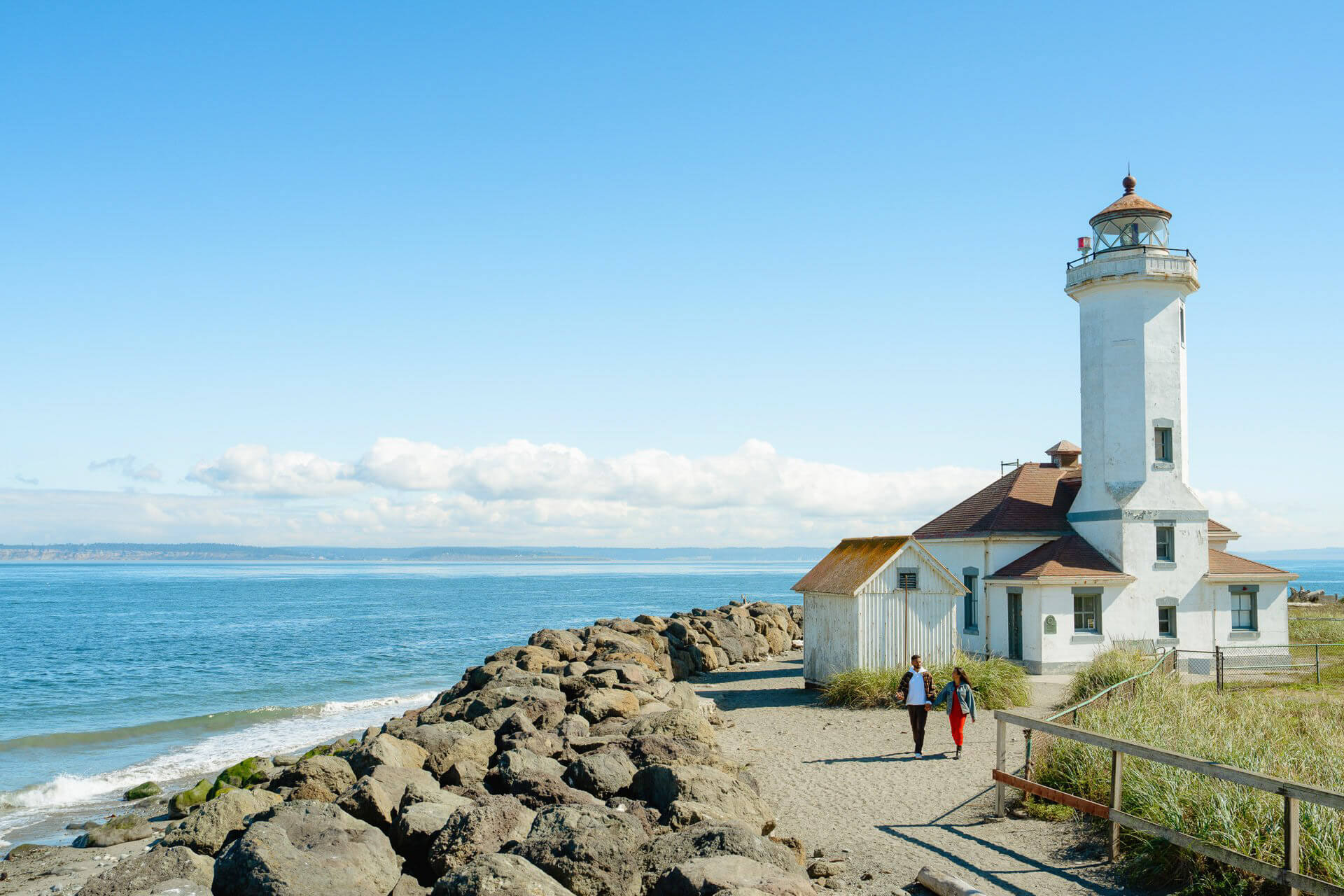
Year built: 1914 (replacing a tower built in 1879 on the roof of the keeper’s house)
The Point Wilson Lighthouse stands at the entrance of Admiralty Inlet and Puget Sound inside Fort Worden Historical State Park. At 51 feet, the beacon is the tallest on Puget Sound. Be sure to explore Fort Worden’s extensive campus, which includes historic buildings, two main museums, and miles of forested trails and beach.
Visitors looking to immerse themselves in maritime life can stay on-site year-round in two lodging options. The historic 1879 lighthouse keepers’ duplex features two bedrooms, while large groups can rent a four-bedroom house originally built as coast guard officer quarters in the 1960s.
Visitor hours and tours: From May through the summer months, lighthouse tours are offered on the weekends.
New Dungeness Lighthouse, Sequim
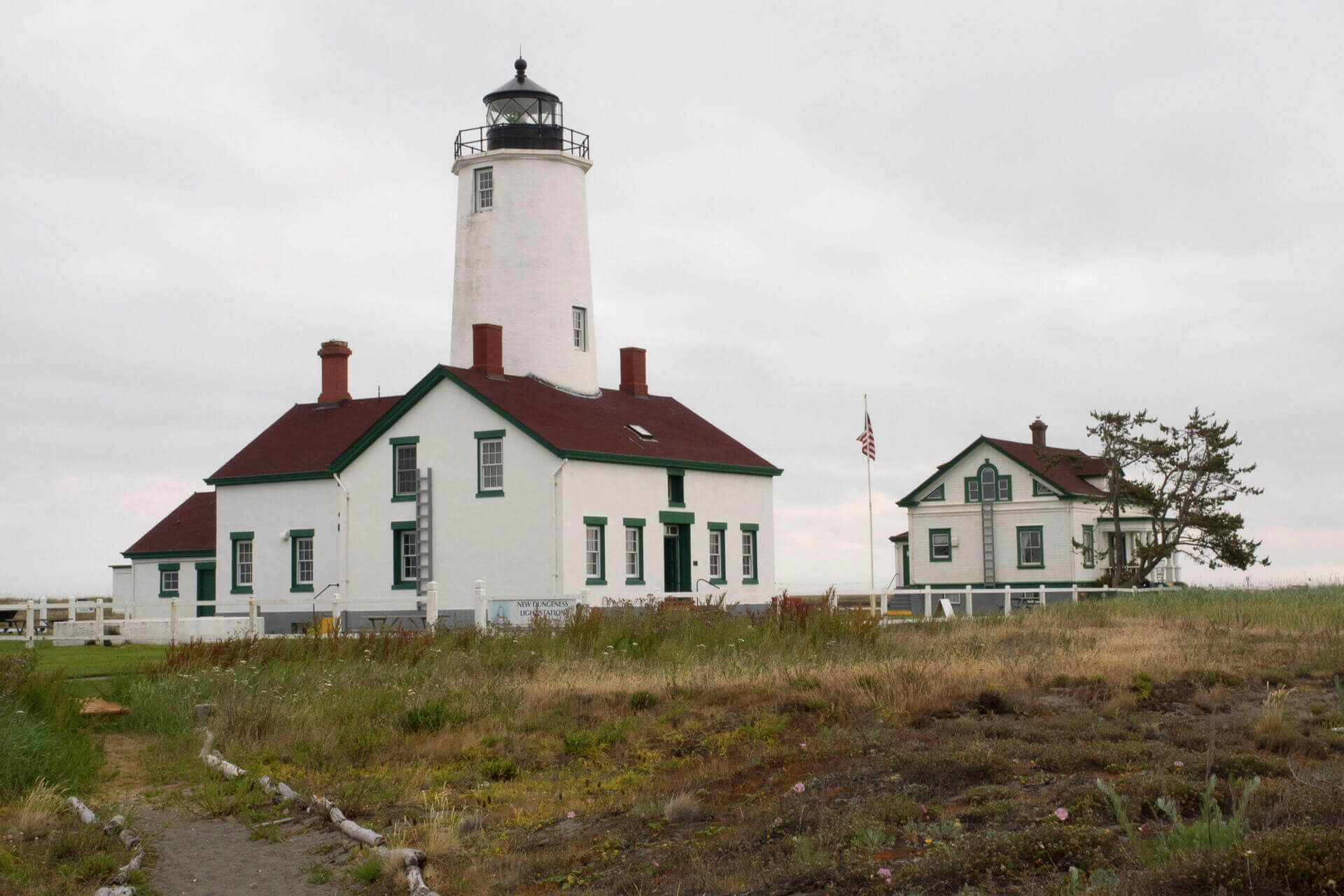
Year built: 1857
Situated at the tip of Dungeness Spit in the Dungeness National Wildlife Refuge, the New Dungeness Lighthouse overlooks the Strait of Juan de Fuca. Getting to this lighthouse is half the fun. From the refuge parking lot, visitors can hike five miles down the narrow Dungeness Spit (note the beach is only walkable at low tide). Kayakers and boaters can access the lighthouse from Cline Spit and are required to contact the Refuge office before landing. Once there, climb the 74 steps for panoramic views.
For an immersive experience, the New Dungeness Keeper Program offers visitors the chance to step into the role of lighthouse keeper for a week. After meeting eligibility requirements, you’ll spend your time along the coast maintaining the lighthouse building and grounds, offering tours to visitors, and soaking up the scenery.
Visitor hours and tours: Free guided tours of the museum and tower are offered daily, although winter hours may vary. Please call to check winter hours.
Also See: Things to Do on the Olympic Peninsula
Grays Harbor Lighthouse, Westport
Year built: 1858
The tallest lighthouse in Washington at 107 feet, the Grays Harbor Lighthouse still boasts its original clamshell-shaped Fresnel lens built in Paris in 1895. Visitors can climb the 135 steps leading up to the lantern room via the original cast-iron spiral staircase.
The lighthouse borders Westport Light State Park, a 560-acre day-use park that includes Half Moon Bay. Stroll along the park’s 1.3-mile ADA-accessible hiking trail hugging the beach to the South Jetty. On the other side of the park, the Westport Maritime Museum displays exhibits on marine mammals, local maritime history, shipwrecks, and more. In the winter months, base yourself in Westport for storm watching.
Visitor hours and tours: The lighthouse building is typically open Thursdays-Sundays year round, although exact hours vary by season. Children must be at least 5 years old to climb the stairs.
Washington Lighthouses: Puget Sound and Northwest Islands
Mukilteo Lighthouse, Mukilteo
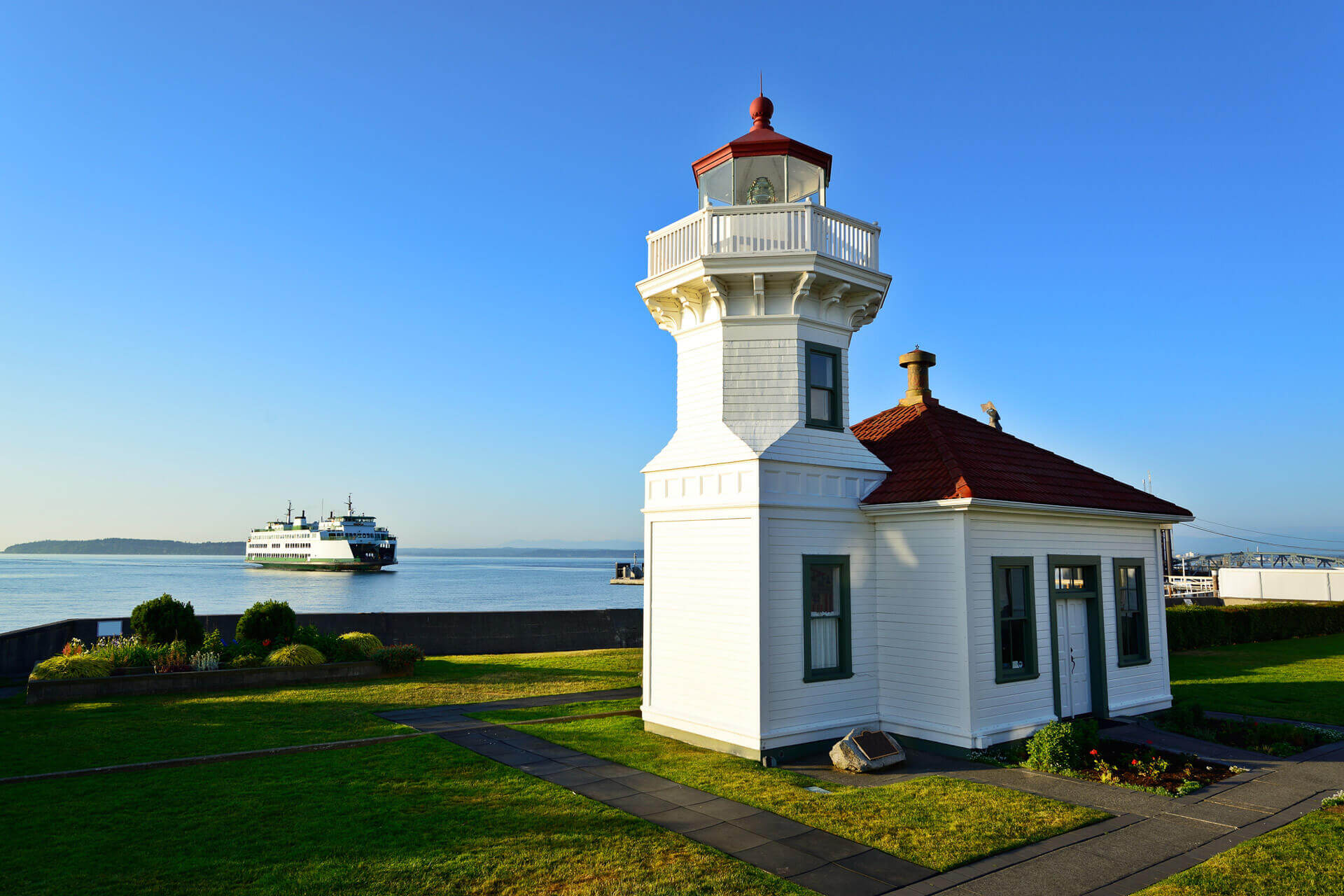
Year built: 1906
This Victorian-style lighthouse made of wood is listed on the National Register of Historic Places. A special Fresnel lens in the Mukilteo Lighthouse makes the light visible from 10 miles away to safely guide ships. Situated in Mukilteo Lighthouse Park, the campus is dotted with historic buildings set along a beach. On a sunny day, the park’s fire pits and shelter are ideal for gatherings and watching the ferries glide to and from Whidbey Island.
Visitor hours and tours: Saturdays and Sundays from April through September.
Burrows Island Lighthouse, Anacortes area
Year built: 1906
This lighthouse sits on the easternmost tip of 300-acre Burrows Island, officially Burrows Island Marine State Park, off the coast of Fidalgo Island in Northwest Washington. The wood-framed building was designed by renowned architect Carl W. Leick, who designed a handful of other lighthouses in Washington, including the Mukilteo Lighthouse in a similar style.
Only accessible by boat, this lighthouse watches over Rosario Strait with its unpredictable riptides. With shoreline consisting primarily of sheer rock, the light station resides on one of the few flat areas. For kayakers, the distance from Anacortes is short but filled with strong currents.
Visitor hours and tours: Not currently available.
Admiralty Head Lighthouse, Coupeville
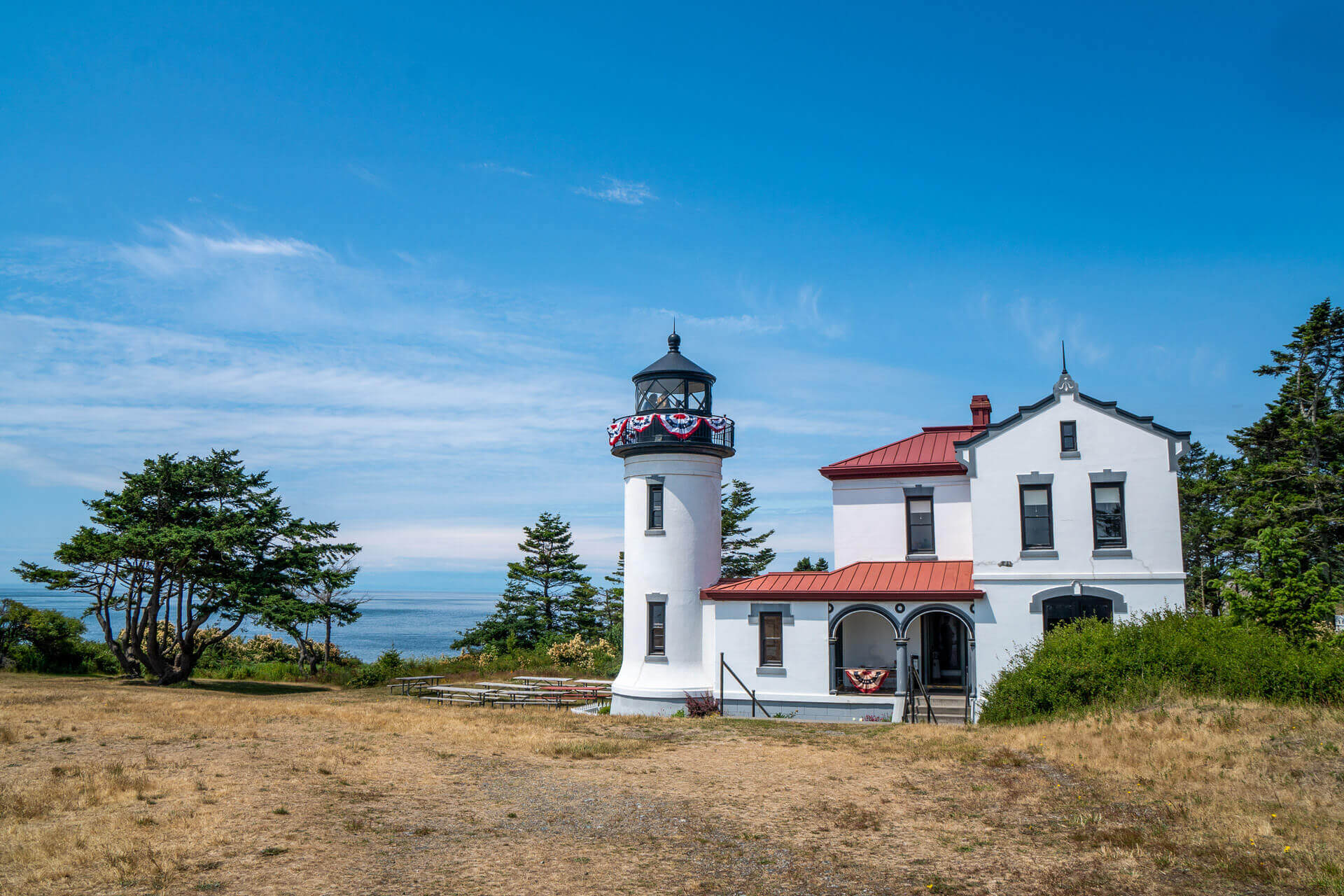
Year built: 1903 (replacing original 1861 lighthouse)
On the western side of Whidbey Island in Fort Casey Historical State Park, this lighthouse stands sentinel over Admiralty Inlet off the Strait of Juan de Fuca. Architecture buffs will notice the Spanish-style design using brick covered with stucco. From the top, visitors have superior views of Puget Sound and the Olympic Mountains. Don’t miss the gift shop and museum displaying maritime artifacts (Discovery Pass required).
Visitor hours and tours: Open daily from June through August, with more limited hours during spring and fall. Closed January and February.
Point Robinson Lighthouse, Maury Island
Year built: 1885
On the east shore of Maury Island near Tacoma, the Point Robinson Lighthouse sits in a 10-acre shoreline park and marine conservancy overlooking the East Passage. Before an air-compression fog whistle was installed in 1915, the light used a steam whistle to communicate with ships. To power that steam whistle, water from its V-shaped roof fed two 11,000-gallon cisterns. Visitors can rent fully restored Keepers’ Quarters, which offer views of the sound.
Visitor hours and tours: Tours are generally offered Sundays from mid-May through mid-September.
Lime Kiln Lighthouse, San Juan Island
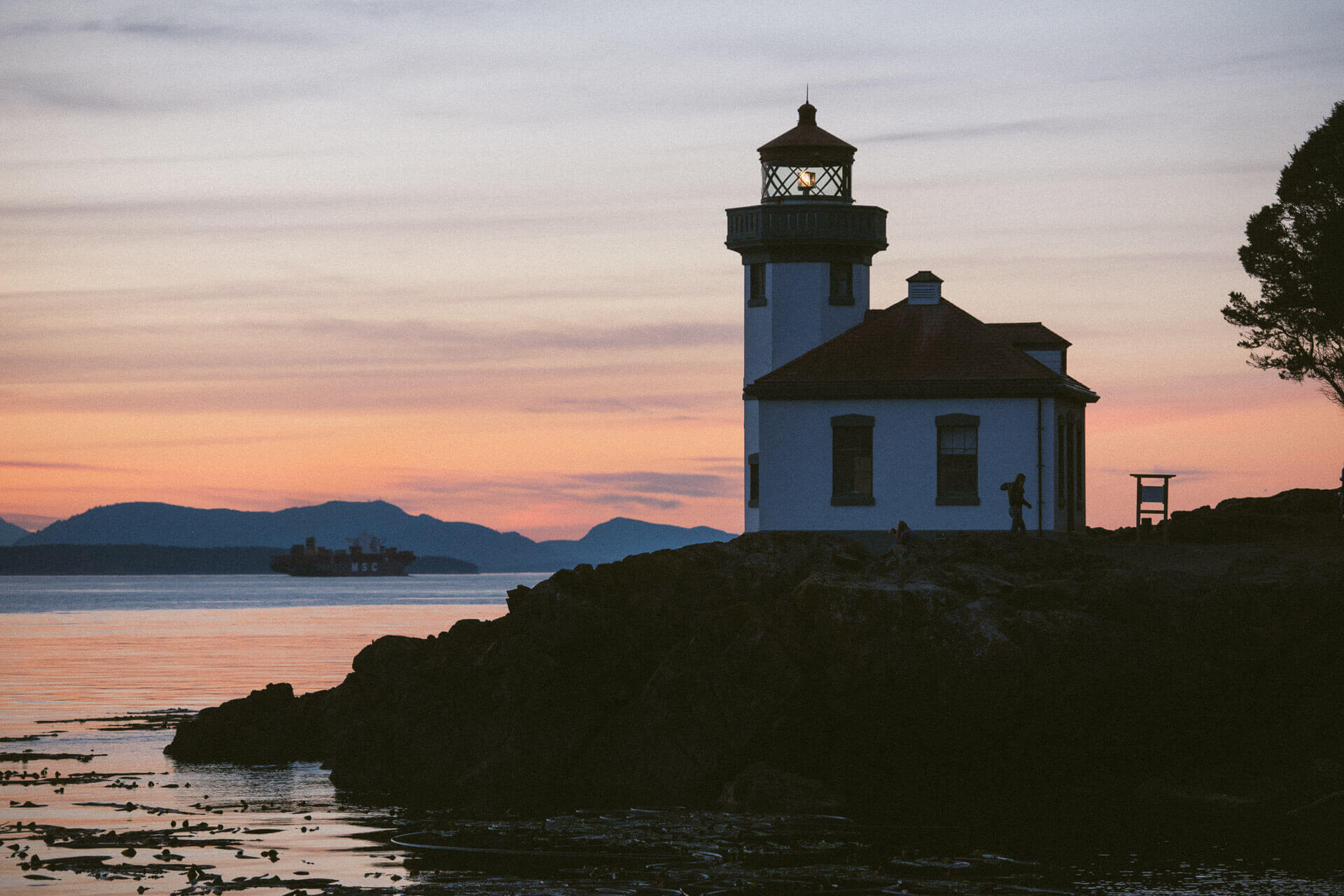
Year built: 1919
One of the most well-known lighthouses in Washington, Lime Kiln Lighthouse on San Juan Island sits along Haro Strait, a waterway connecting the Puget Sound with the Strait of Georgia. The lighthouse is named for the island’s lime kilns built in the 1860s, and remains of the kilns can be found north of the building. The lighthouse perch—and the surrounding 41-acre Lime Kiln Point State Park—is known as one of the best land-based places for whale watching in Washington.
Visitor hours and tours: Friends of Lime Kiln Society typically offers tours of the Interpretive Center and lighthouse on Thursday and Saturday evenings from mid-May to mid-September.
Point No Point Lighthouse, Hansville
Year built: 1879
The Point No Point Lighthouse is the oldest on Puget Sound. About an hour from Seattle, this lighthouse on the Kitsap Peninsula boasts a 90-foot radar tower that still works as a vital navigational tool for the Coast Guard’s Vessel Traffic Service. Listed on the National Register of Historic Places, the light station campus is home to other historic buildings, including the picturesque Keepers’ Quarters, which is available to rent.
As of fall 2025, the main parking lot remains closed due to storm damage. However, the park and lighthouse are open to pedestrian traffic, and a Washington Department of Fish and Wildlife parking lot on Point No Point Road is open seasonally (Discover Pass required).
Visitor hours and tours: Open Saturdays and Sundays from April through September.
Also See: Kitsap Peninsula Road Trip Guide
Patos Island Lighthouse, near Orcas Island
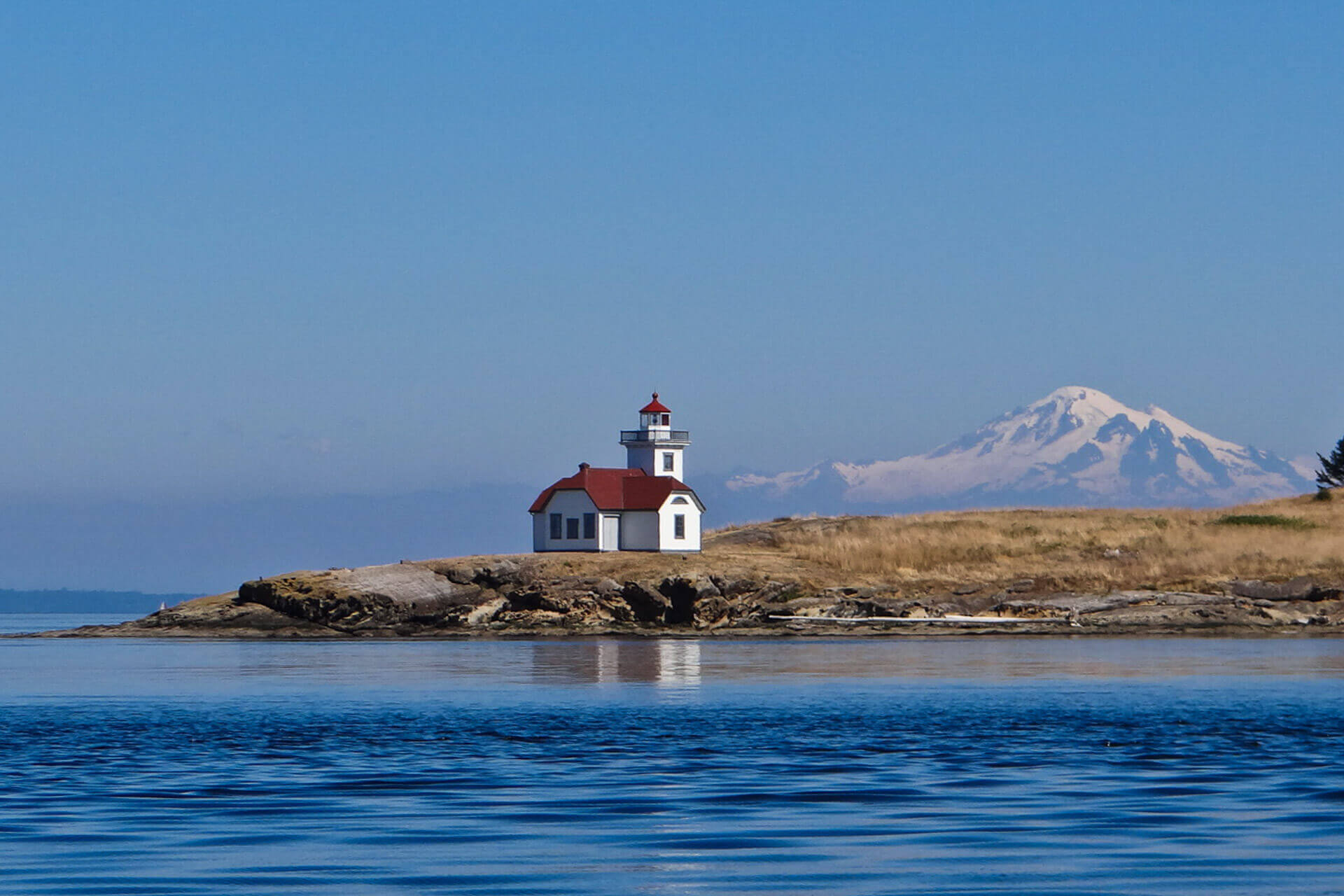
Year built: 1893 (for the fog-signal building), 38-foot tower added in 1908
Named by an 18th-century Spanish explorer, 210-acre Patos Island has coves and caves that were once popular hideouts for smugglers hauling contraband. Due to its isolated location, this is one of the lesser-visited lighthouses in Washington.
After the light was automated in 1974, the buildings were abandoned and fell into disrepair. Following renovations in 2008-2009, visitors can now visit the historic site at Patos Island Marine State Park by boat, water taxi, or as part of a guided tour. Only very experienced kayakers should consider making the significant journey from Orcas Island.
Visitor hours and tours: Available Memorial Day through Labor Day if volunteers from Keepers of the Patos Light are on site (look for a sign on the beach in Active Cove).
Visiting Lighthouses in Washington FAQ
Do I need a Discover Pass to visit Washington’s lighthouses?
Sometimes, yes. For lighthouses that sit on state park land, a Discover Pass is required to park. Annual and day-pass versions are available to purchase in advance online and in person through approved vendors. Some state lands have pay stations for day passes.
Which Washington lighthouses can I climb?
Access varies by season and staffing. Some options for climbing include Grays Harbor Lighthouse in Westport, the New Dungeness Lighthouse near Sequim, and North Head Lighthouse near Ilwaco. Always check current hours and tour availability before visiting these landmarks and historical sites.
When is the best time to visit lighthouses in Washington State?
Washington lighthouses can be visited year-round for scenic views. For open towers and programs, late spring through early fall is best. Winter brings powerful surf and storm-watching opportunities for lighthouses along the Pacific Coast.
Can I stay overnight at a lighthouse keeper’s quarters?
Yes, some sites offer historic lodging, including the Point Wilson Lighthouse near Port Townsend, Point No Point near Hansville, and North Head in Cape Disappointment State Park.
Which lighthouse is the tallest in Washington?
The Grays Harbor Lighthouse in Westport is tallest at 107 feet. There are 135 steps leading up to the tower.
About the Author
Ellee Thalheimer is a freelance writer and guidebook author based in the Pacific Northwest who has contributed to publications like Lonely Planet Guidebooks, Alaska Airlines Magazine, and Adventure Cyclist Magazine. When she can’t get outside, she writes fiction, drinks local IPAs, and perfects her handstands.
